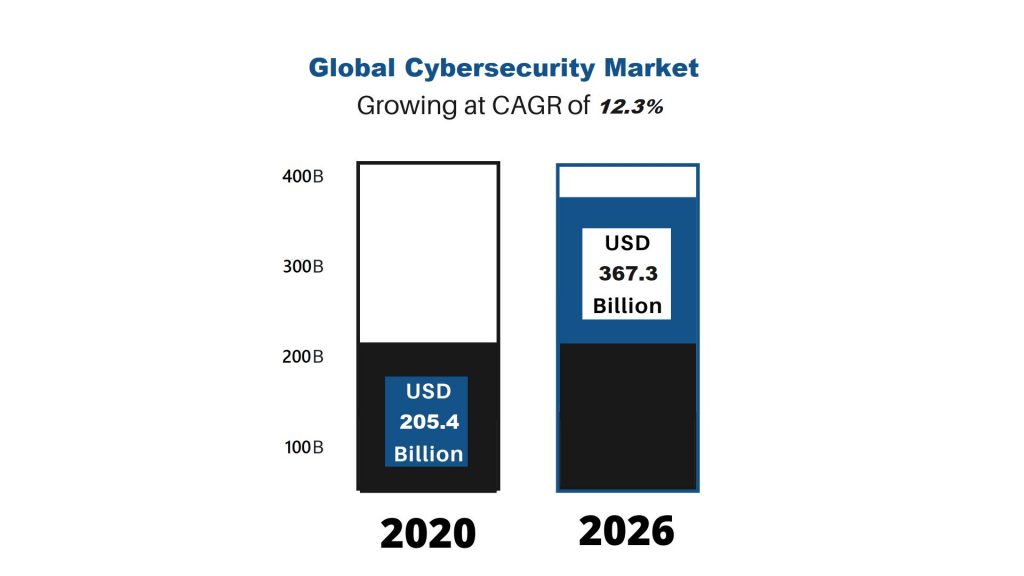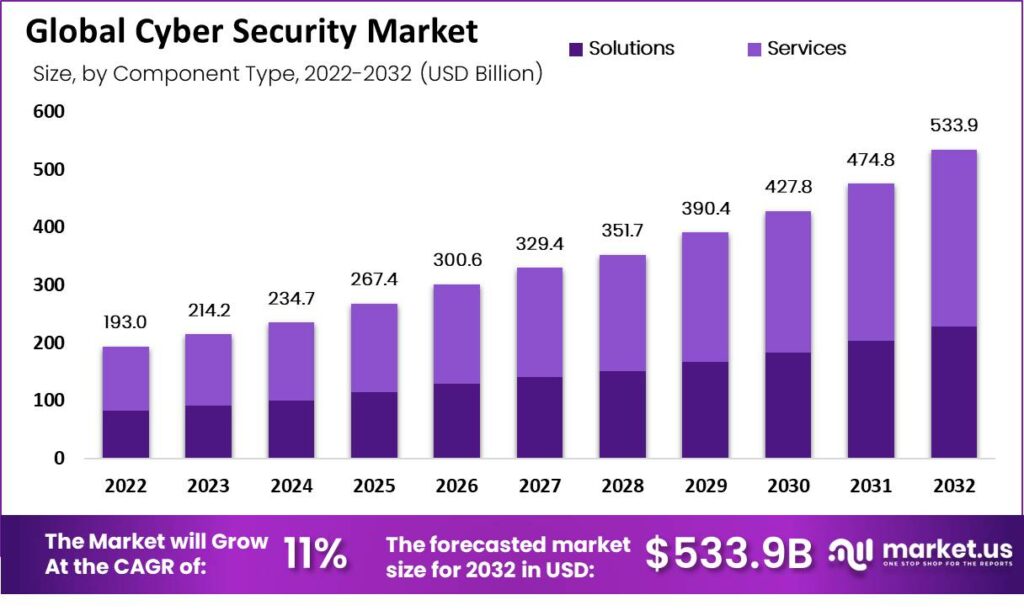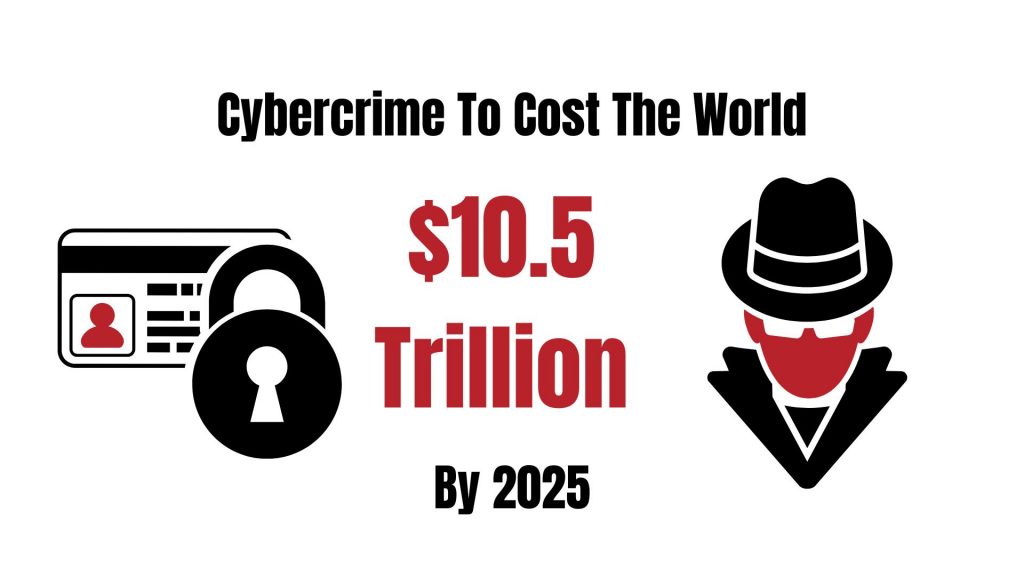Cyber Security Statistics 2024 Facts and Trends That Users Need To Know

Page Contents
Cyber Security Statistics: Nowadays the threats of document theft and other cyber crimes have become more prevalent than ever. In such a scenario, cyber security has become a ‘must-have' tool for internet users. Cyber security is vital for everyone who uses the internet; however, it is especially critical for firms and businesses that have a remote workforce.
Many companies invest in antivirus software, firewalls, and cyber insurance to protect their private data and to build their defense against cyber criminals. Here we will discuss some crucial cybersecurity statistics and facts that will help people avoid cyber threats and pivot their online behavior to keep their confidential data safe and secured.
Editor’s Choice
- The cyber security market is predicted to reach up to USD 533.9 Billion by 2032.
- During the pandemic, about 60% of internet users felt more at risk of data theft.
- In 2022, cyber criminals caused damages of USD 6 trillion.
- Every 39 seconds, there's a cyber attack somewhere in the world.
- A ransomware attack happens every 14 seconds globally.
- Small businesses usually spend less than USD 500 on cyber security.
- Cyber crimes have cost us USD 2 trillion so far.
- The FBI received over 2000 reports of cyber crimes in 2020.
- Early in 2021, ransomware crimes jumped by 102%.
- Over 75% of cyber attacks start with a scam email.
- In 2023, companies making over USD 5 billion spent around USD 250 million on cyber security each year.
- Yet, 71% of businesses spent less than USD 250 million on security annually.
- By September 2023, 91% of companies worldwide had faced at least one cyber attack.
- Of these, 56% experienced serious or moderate damage.
- 55% of businesses said cyber security policies let them innovate safely.
- T-Mobile had the most data breaches in 2023.
- Yahoo had a huge breach in 2013, affecting 500 million accounts.
- Spending on security training for employees is expected to hit USD 10 billion by 2027, up from USD 5.6 billion in 2023.
- There were about 3.5 million open cyber security jobs in 2023.
- By 2025, the cost of cyber crime could reach USD 10.5 trillion worldwide.
- Many cyber attacks happen because of weak security.
- It usually takes 197 days to find a breach. Fixing it within 30 days could save a lot of money, but delays can cost up to USD 4.25 million.
Key Cyber Security Statistics
- Rate of Cyber crime Increase: During the COVID-19 pandemic, cyber crime rates soared by 600%, showcasing how threats have adapted to changing global conditions.
- Phishing Attacks: Phishing remains the most common form of cyber attack, accounting for 90% of data breaches. Surprisingly, 96% of these phishing attacks are delivered via email.
- Ransomware Attacks: In 2023, a staggering 72.7% of organizations experienced a ransomware attack. The costs associated with ransomware are expected to climb to USD 265 billion annually by 2031.
- Data Breach Costs: The global average cost of a data breach in 2023 reached USD 4.45 million, reflecting a 15% increase over three years. The United States had the highest cost at USD 5.09 million per breach.
- Cyber security Insurance: Cyber insurance premiums in the US saw a 50% hike in 2022, with premiums collected amounting to USD 7.2 billion.
- Skills Gap in Cyber security: The cyber security sector is expected to have 3.5 million unfilled positions by 2025, underscoring the significant skills gap and the increasing demand for cyber security professionals.
- Email-Based Threats: Over 75% of targeted attacks initiate from an email, with 94% of malware being delivered through this channel.
- Rising Costs of Cyber crime: Cyber crime costs are on a steep rise, expected to reach USD 10.5 trillion annually by 2025, marking a 15% yearly increase.
- Healthcare Industry Spend: The healthcare sector is projected to spend USD 125 billion on cyber security between 2020 and 2025, highlighting the industry's vulnerability and the critical need for robust security measures.
You May Also Like To Read
- SSL Statistics
- Backup Statistics
- Employee Theft Statistics
- Phishing Statistics
- Hacking Statistics
- Data Breach Statistics
- Two-Factor Authentication Statistics
- Cloud Security Statistics
- Chinese Cyber Attack Statistics
- Identity Theft Statistics
Cyber Security Trends
- The adoption of proactive security tools is becoming essential, with organizations urged to invest more in technologies that detect vulnerabilities and security gaps early.
- Regulatory scrutiny on IoT and embedded devices is expected to increase, highlighting the necessity for more robust security measures in these areas.
- There's a notable rise in politically motivated hacktivist attacks, with some targeting operational technology (OT) systems, indicating a need for heightened security awareness and preparedness.
- Social engineering attacks, particularly phishing, continue to pose significant threats, underscoring the importance of ongoing vigilance and education.
- The Deep & Dark Web remains a hotspot for cyber criminal activities, with retail/e-commerce, financial institutions, and technology services sectors being the most targeted.
- Generative AI (GenAI) is beginning to play a more significant role in cyber security, both in enhancing threat prevention and in enabling security analysts to tackle more complex challenges.
- The global market for zero trust security models is expected to reach $51.6 billion by 2026, indicating a shift towards more stringent access controls and verification processes.
- Ransomware attacks have seen a dramatic increase, highlighting the need for effective response and recovery strategies to mitigate the impact of these attacks.
AI in Cyber Security Statistics
- Adoption by Telecom Organizations: A significant 80% of telecom organizations have adopted AI-driven cyber security solutions, reflecting AI's growing dominance in safeguarding complex network infrastructures.
- Executive Perspective: About 69% of senior executives view AI as essential for responding to cyber security threats, highlighting the increasing reliance on AI technologies to bolster cyber defenses.
- Market Growth: The AI in cyber security tech is expected to grow at an impressive annual rate of 23.6% until 2027, indicating the rapid evolution and investment in AI-enhanced security measures.
- Privacy Compliance: Up to 40% of privacy-compliance technology will rely on AI by 2023, signifying AI's expanding role in ensuring data privacy and compliance with regulatory standards.
- Reduction in Risky User Behavior: Implementation of AI in cyber security policies has led to a 68% decrease in risky user behavior, showcasing AI's effectiveness in promoting safer digital practices.
- Generative AI's Influence: Generative AI is set to play a significant role in cyber Security, with innovations and challenges expected in areas like email security and social engineering attacks.
- AI in Cyber Security Market: The market for AI in cyber security was valued at approximately USD 17.4 billion in 2022 and is predicted to reach around $102.78 billion by 2032, growing at an annual rate of 19.43% from 2023 to 2032.
Cyber Security Market Statistics
#1. Global expenditure on cyber security reached $6 trillion in 2021
According to Cyber security Ventures, Cyber crime is expected to cost the entire world $10.5 Trillion annually by 2025. This is up from $3 Trillion a decade ago, and $6 Trillion in 2021. It will be vital that cyber security spending continues to grow in proportion to this increase.
#2. The worldwide cyber security market is estimated to reach up to $300 billion by 2026
The value of the cyber security market is growing rapidly. Experts predict that it can easily grow by two or threefold in the next three years as the demand for cyber security services and solutions is growing.

(Source: Research And Market)
#3. According to Market.us, Cyber Security Market size is expected to be worth around USD 533.9 Billion by 2032.
The Global Cyber Security Market size is expected to be worth around USD 533.9 Billion by 2032 from USD 193 Billion in 2023, growing at a CAGR of 11% during the forecast period from 2022 to 2032.

#4. Tech giant Microsoft spends nearly $1 billion per year on cyber security
Considering the greatest challenge of the digital age, Microsoft continues to fight against modern-day cyber security threats. This investment of the tech giant does not include the company's extra expenditure on acquisitions in the cyber security market.
#5. Small firms invest fewer than USD 500 in cyber security on average
Small firms are too cautious about cyber security. They generally opt for consumer-grade security services. Small firms account for 13 percent of the cyber security market. Cyber security statistics show that small businesses are lucrative targets for cyber criminals.
#6. JPMorgan Chase invests around USD 600 million in cyber security services per year
JPMorgan has over 3,000 workers in its cyber security unit. The company has increased its yearly cyber security budget by 100 million.
#7. Every third company in the US has invested in liability coverage or cyber data breach insurance coverage
With specialized insurance coverage, companies can recover their losses, even if firewalls and cybersecurity solutions are disrupted somehow. As per cybersecurity statistics, around 68 percent of firms still do not have such insurance coverage and 25 percent of firms are planning to invest in it.
#8. The Cyber Insurance market is expected to reach $20 billion in the next three years
Experts estimate that the cyber insurance market will surpass the $20 billion mark in another five years and the majority of growth will be led by firms based in the US.
#9. Firms give up to USD 500000 to hackers to test their systems
People widely known as ‘White Hat' hackers do not utilize their skills for immoral purposes rather they help companies such as Tesla to toughen their security systems.
Cyber Crime Statistics
#9. 1 out of 10 small firms experiences a cyber attack per year
Cyber security statistics show that small businesses need to spend on cyber security, as small firms are easy targets of cyber criminals.
#10. Every 14 seconds a ransomware attack takes place
According to Cyber security Ventures, Ransomware is the most lucrative type of malware. Ransomware attacks are more prevalent now than ever.
#11. Every 39 seconds a cyber attack takes place
The latest cyber security statistics show that an unsecured system connected to the internet can be a target of more than 2,000 cyber attacks each day. Hackers use automated tools and scripts to investigate their targets for susceptibilities.

(According to Cybersecurity Ventures)
#12. Only 10% of cyber crimes are reported in the US
Despite being the home of many tech giants and a huge part of the internet industry, only 10% of cyber crimes are reported in the United States. It happens because often it is hard to prove that cyber crime has taken place.
#13. Cyber security stats show that the US will be a lucrative target for more than 50% of cyber crime attacks by 2027
Cyber security predictions reveal that the US going to be a soft target for more than half of cyber crime attacks in another five years, hence US-based companies should consider reinforcing their protection against cyber threats.
#14. The first reported death due to a ransomware attack took place at a hospital in Germany
In September 2020, the first known death due to a ransomware attack happened after a ransomware-led IT failure occurred at a hospital in Dusseldorf, Germany.
#15. More than 90% of successful cyber attacks against trades are generated from phishing
The latest cyber security statistics indicate that phishing is still one of the most popular types of cyber attack. It works for most cyber criminals because it exploits human nature.

#16. Phishing contributes to 37% of all cyber crime attacks targeted at businesses
More than one-third of all cybercrime attacks endured by firms are led by phishing.
#17. Bitcoin leads to illegal activities worth USD 76 billion each year
Bitcoin is the most popular cryptocurrency in the world; however, it has witnessed its own share of cyber violence and malicious activities. Crypto transactions offer anonymity, which is an enviable factor when somebody is doing something illegal. Experts say that at least one-quarter of total Bitcoin users have been involved in illegal activities at least once.
#18. The biggest DDoS attack led to the transfer of 1.3 TB of data per second
Software depository platform GitHub suffered a massive DDoS attack in 2018. In this cyber attack, cyber criminals transferred around 1.3 TB of data every second.
#19. Data breaches are mostly financially motivated
Credentials are one of the most popular data forms in data breach incidents, which is followed by personal details.
#20. DDoS attacks are 39% more prevalent than the last year
The latest cyber security statistics show that cyber criminals are using DDoS attacks more often than ever. There has been a 776% increase in such kinds of attacks that have used 100-400 Gbps of data within a year. DDoS attacks usually target satellites and wireless communication firms.
#21. Cyber criminals need only USD 1 to obtain their tools
Hackers can obtain a simple malware kit for just $1. Hackers need only $25 to get a million compromised emails or passwords. Many other hacking tools and kits cost only a few hundred dollars.
#22. Around 85% of data breaches are led by a human element
#23. During data breaches, external cloud data are more at risk as compared to on-premise assets.
Cyber Crime Cost And Damage Statistics
#24. The annual damage led by cyber crimes is predicted to reach USD 10.5 trillion by 2025
The yearly damage caused by cyber crime attacks is expected to reach $6 trillion in 2022. Experts say that cyber security threats have already led to damage worth USD 2 trillion so far.

(According to Cybersecurity Ventures)
#25. Companies lose around USD 188400 per year on average due to cyber crime attacks
Big and small businesses lose a large portion of their time and money fighting against such cyber crime attacks. Around 97% of small firms have been able to cover their costs as they have been secured by cyber insurance.
#26. Companies based in the US are less likely to give away a ransom amount to hackers
Most companies in the US follow the mantra of not negotiating with terrorists. As per cyber security statistics, only 3% of US-based firms have paid ransom amounts to cyber criminals.
#27. FedEx lost USD 300 million in damages after a ransomware attack
When FedEx suffered a cyber security breach, its stock fell by 79% per share.
#28 The city of Atlanta lost around USD 17 million in recovery after suffering a ransomware attack
SamSam ransomware attackers demanded a payment of USD 51000 that was refused by the city. Initial damage from this attack was predicted at USD 3 million, however, it grew sixfold as some part of the compromised data involved police records and one-third of the city's programs.
#29. The healthcare industry is estimated to spend USD 125 billion on cyber security services from 2020 to 2025
In 2018, every other ransomware attack targeted the healthcare sector. Hackers have been attacking the healthcare sector more frequently. Sourced from Cybersecurity Ventures.
#30. Formjacking attacks account for damages worth USD 2.2 million each month
Around 4800 websites suffer from jacking attacks every month. Such attacks help cyber criminals steal users' data like credit card details, logins, and password credentials.
#31. As per cybersecurity stats, 47% of cybercrime victims lose money after being attacked by a cybercrime.
#32. Victims of infected business and personal email accounts suffered a loss of USD 1.86 billion in 2021.
Data Breach Statistics And Facts
#33. Experts estimated that a data breach would cost damage worth USD 13 million in 2021 on average
Although investments in cyber insurance are growing, data breaches as well will continue to increase in the forthcoming years.
#34. The greatest data breach in history compromised 3 billion user accounts
Yahoo suffered a massive data breach attack that was reported in 2017. As per cybersecurity stats, it is the biggest security breach incident in history.
#35. Facebook also suffered a security breach recently
In 2019, one of the most popular social networking platforms, Facebook experienced a major security breach. This attack on Facebook made account names, comments, user IDs, and reactions publicly available. Experts found that the passwords of around 600 million FB accounts had been stored as plain text files after the security breach.
#36. Cybersecurity statistics show that around 95 user credentials are stolen each second
More than 3 billion passwords and other credentials are compromised or stolen per year whether through data breaches or malware. Services like e-banking now need regular password updates. Experts suggest that people should have different passwords for each website or app.
Facts About Cyber Security
#37. The US Colonial Pipeline made a USD 5 million Bitcoin payment to hackers after suffering a VPN attack in April 2021.
This attack affected the multi-factor authentication system of the company.
#38. Spam has been the most sought-after type of cyber threat leveraging the COVID-19 pandemic
Spam emails accounted for 65.7% of online threats linked to the COVID-19 pandemic.
#39. 44% of adults felt more vulnerable to cyber attacks during the COVID-19 pandemic as compared to pre-COVID times
Due to the changes in lifestyle during the pandemic, nearly two out of five adults took measures to protect their online activities and personal details.
#40. FBI saw a 300% increase in reported cyber crime attacks since COVID-19
These cyber-attacks included ransomware attacks that demand cryptocurrency payment.
#41. Most firms do not think they are adequately protected from cyber crime attacks
As per a survey, more than half of surveyed firms have shown concerns regarding the safety of their data. The majority of firms think that they require more robust protection against cyber attacks.
#42. Despite greater security concerns, the most frequent password is 123456
Most passwords are quite easy to crack. Cyber security facts reveal that common and obvious passwords remain major concerns.
#43. Apart from financial loss, a cyber crime attack can damage a company's reputation as well
Cyber attacks can hamper the public image of the company as well along with affecting its employees and clients due to data breaches.
#44. Nearly 58% of firms have more than 100,000 unprotected folders
Network firewalls are the basic line of defense. If companies have enough protection for additional folders, hackers cannot do much even if they break through the company's system. However, about 60% of firms have much scope for huge preventable vulnerability.
#45. Every third user account is recognized as a stale account
Even if an employee leaves the company, their account remains active for a long time. It is known as a stale account. Such stale accounts work as a potential entry point for cyber criminals.
#46. Around 4 out of 10 firms carry more than 1000 unprotected sensitive files on their servers
Many companies have not properly protected their sensitive files such as health records, credit card numbers, and Social Security numbers. Such files pose a great security risk.
#47. Only one out of 5 people in the US update their passwords after hacking is shown in news reports
Most people do not change their passwords until they find it hard to recall. Only 20% of people in the US change their passwords after knowing about security breach attacks.
#48. More than 60% of firms account for more than 1,000 stale user accounts
It can be risky for companies to retain thousands of obsolete user accounts.
#49. IoT devices can be compromised just minutes after they are connected to the internet
IoT devices such as smart TVs, cars, speakers, and thermostats are not as safe as we think. Cyber security statistics show that such devices are the easiest entry spots for cyber criminals. IoT devices do not have any integrated protection; therefore, network firewalls are the best option available.
#50. Users should avoid using third-party app stores for malware-free smartphone
Human error remains the most popular cause of security breaches. Users should use the manufacturers' app only to keep their smartphones safe from hackers.
#51. There are five kinds of cyber security available
Protecting critical infrastructure, network security, cloud security, computer applications, and IoT security are five forms of cybersecurity.
#52. 53% of adults believe that remote work has helped cyber criminals and hackers to take advantage of people.
#53. Cloud-based storage and apps also require proper defense against hackers.
Recent Happenings
- AnyDesk Cyber Attack: The remote desktop software company, AnyDesk, experienced a cyber attack compromising its production systems. The incident led to the revocation of all security-related certificates and passwords to its web portal as a precautionary measure.
- Russian APT28 Hackers Targeting: The state-sponsored group known as APT28 has been targeting organizations worldwide in sectors such as foreign affairs, energy, defense, and transportation with NTLM Relay Attacks.
- DirtyMoe Malware in Ukraine: Over 2,000 Ukrainian computers were infected by the DirtyMoe malware, capable of conducting cryptojacking and DDoS attacks.
- Cloudflare Breach: Cloudflare disclosed a breach by likely nation-state actors who accessed some documentation and a limited amount of source code.
- US Sanctions Iranian Officials: In response to cyberattacks against an Israeli PLC vendor, the US government has sanctioned six Iranian government officials.
- Layoffs at Security Vendors: Okta and Proofpoint announced layoffs affecting nearly 1,000 employees in the US and Israel.
- Clorox Cyberattack Costs: Clorox reported that a cyberattack has cost the company over $49 million so far, with more costs expected in 2024.
Conclusion
In 2024, the cyber security continues to evolve rapidly, driven by both the advancement of technology and the ingenuity of cyber criminals. The World Economic Forum's Global Cyber security Outlook and other key sources indicate that credential leaks, despite remaining stable in number, have seen a shift towards more sophisticated acquisition methods by cyber criminals, with a significant portion of these credentials being corporate.
This underscores the critical need for robust corporate cyber security measures to protect against such threats. Furthermore, the sophistication of attacks is on the rise, with ransomware groups increasingly adopting advanced tactics and targeting specific industries based on their vulnerability and potential ransom payoff. This trend towards more targeted and financially motivated cybercrimes highlights the urgent need for organizations to bolster their defenses and adopt proactive security measures.
The statistics also paint a picture of a digital world where no sector remains unscathed, with cyber crime predicted to cost the world significantly. The United States continues to bear the highest cost of data breaches, emphasizing the need for increased investment in cyber security measures. In response to these challenges, the emphasis on leveraging artificial intelligence for threat intelligence and automation is growing, presenting a promising avenue for enhancing organizational security posture.
As the cyber threats becomes increasingly complex, the importance of comprehensive monitoring, swift response, and the adoption of AI-driven technologies cannot be overstated. Organizations must prioritize these strategies to navigate the complexities of the current cyber security landscape, ensuring resilience against the ever-evolving threats.
Sources
FAQ.
Around 2000 cybercrime complaints were reported in the US in 2021.
More than 2200 cybercrime attacks take place each day. Around one cybercrime attack occurs every 39 seconds.
Reportedly, the majority of hackers are from China and Turkey.
As per the 2021 cybersecurity statistics, phishing is the most common form of the cyber attack reported in the US.
Healthcare and pharmaceuticals, public administration, finance and insurance, education and research, and retail are five industries that are at a higher risk of cybercrime attacks.

Barry is a lover of everything technology. Figuring out how the software works and creating content to shed more light on the value it offers users is his favorite pastime. When not evaluating apps or programs, he's busy trying out new healthy recipes, doing yoga, meditating, or taking nature walks with his little one.